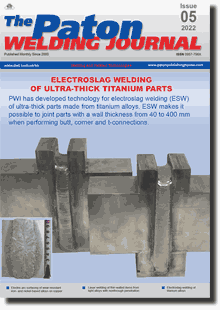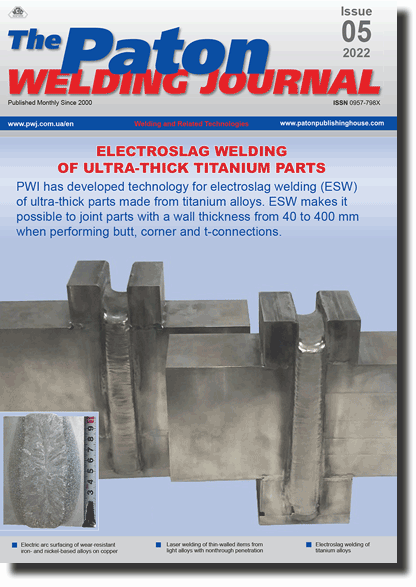| 2022 №05 (01) |
DOI of Article 10.37434/tpwj2022.05.02 |
2022 №05 (03) |

The Paton Welding Journal, 2022, #5, 10-15 pages
Electric arc surfacing of wear-resistant iron and nickel-based alloys on copper
I.O. Ryabtsev1, A.A. Babinets1, I.P. Lentyugov1, I.L. Bogaychuk1, A.I. Panfilov2
1E.O. Paton Electric Welding Institute of the NASU. 11 Kazymyr Malevych Str., 03150, Kyiv, Ukraine. E-mail: ryabtsev39@gmail.com
2WSC «Steel Work» 50 Myru Prosp., 50000, Kryvyi Rih, Ukraine
Abstract
The results of studying the formation of welded joint in electric arc surfacing on copper by the wires, providing a deposited metal based on iron and nickel, which according to the authors and publications in the technical literature, have a high resistance to different types of wear at elevated temperatures. The modes were selected and technologies of arc surfacing on a copper base by selected wires were developed, which provide a satisfactory formation of the deposited metal and its fusion with the base metal. According to the results of experiments on electric arc surfacing on copper, as well as the study of macro- and microstructure of deposited specimens, it was shown that the best results in terms of welding and technological properties are provided by the use of the nickel-based wire. The admissibility of individual defects that were found in the deposited metal and on the fusion line of the base and deposited metals during studies will be determined by the operating conditions of specific parts.
Keywords: surfacing on copper, wear-resistant alloys, electric arc surfacing, copper, weldability, fusion zone
Received: 19.04.2022
Accepted: 08.08.2022
References
1. Gurevich, S.M. (1990) Spravochnik po svarke cvetnyh metallov [Non-ferrous metal welding guide]. Kiev, Naukova dumka, [in Russian].2. Lide, D.R., Haynes, W. (2018) CRC Handbook of chemistry and physics: a ready-reference book of chemical and physical data. Boca Raton, Taylor and Francis.
3. Babinets, A.A., Ryabtsev, I.O., Lentyugov, I.P. et al. (2020) Problems and prospects of surfacing of copper and copper parts by wear-resistant layers (Review). The Paton Welding J., 5, 15-23. https://doi.org/10.37434/tpwj2020.05.03
4. Rjabcev, I.A., Senchenkov, I.K., Turyk, Je.V. (2015) Naplavka. Materialy, tehnologii, matematicheskoe modelirovanie [Surfacing. Materials, technologies, mathematical modeling]. Gliwice, Wydawnictwo Politechniki Slaskiej, [in Russian]. https://doi.org/10.15407/tpwj2015.06.29
5. Pereplyotchikov, E.F. (2004) Plasma-powder cladding of wear- and corrosion-resistant alloys in valve manufacturing. The Paton Welding Journal, 10, 31-37.
6. Pereplyotchikov E.F. (2015) Plasma-powder surfacing of nickel and cobalt alloys on copper and its alloys. The Paton Welding Journal, 5-6, 10-13. https://doi.org/10.15407/tpwj2015.06.02
7. Silva, C.C., de Miranda, E.C., Motta, M.F. et al. (2012) Dilution control of weld overlay superalloys using Taguchi method. Proc. of the ASME 31st int. conf. on ocean, offshore and arctic engineering, 6, 289-299. https://doi.org/10.1115/OMAE2012-83971
8. Robert, W. Messler (2019) A Practical Guide to Welding Solutions: Overcoming Technical and Material‐Specific Issues. Wiley‐VCH Verlag GmbH & Co. KGaA. https://doi.org/10.1002/9783527818815
Suggested Citation
I.O. Ryabtsev, A.A. Babinets, I.P. Lentyugov, I.L. Bogaychuk, A.I. Panfilov (2022) Electric arc surfacing of wear-resistant iron and nickel-based alloys on copper. The Paton Welding J., 05, 10-15.The cost of subscription/purchase order journals or individual articles
| Journal/Currency | Annual Set | 1 issue printed |
1 issue |
one article |
| TPWJ/USD | 384 $ | 32 $ | 26 $ | 13 $ |
| TPWJ/EUR | 348 € | 29 € | 24 € | 12 € |
| TPWJ/UAH | 7200 UAH | 600 UAH | 600 UAH | 280 UAH |
| AS/UAH | 1800 UAH | 300 UAH | 300 UAH | 150 UAH |
| AS/USD | 192 $ | 32 $ | 26 $ | 13 $ |
| AS/EUR | 180 € | 30 € | 25 € | 12 € |
| SEM/UAH | 1200 UAH | 300 UAH | 300 UAH | 150 UAH |
| SEM/USD | 128 $ | 32 $ | 26 $ | 13 $ |
| SEM/EUR | 120 € | 30 € | 25 € | 12 € |
| TDNK/UAH | 1200 UAH | 300 UAH | 300 UAH | 150 UAH |
| TDNK/USD | 128 $ | 32 $ | 26 $ | 13 $ |
| TDNK/EUR | 120 € | 30 € | 25 € | 15 € |
AS = «Automatic Welding» - 6 issues per year;
TPWJ = «PATON WELDING JOURNAL» - 12 issues per year;
SEM = «Electrometallurgy Today» - 4 issues per year;
TDNK = «Technical Diagnostics and Non-Destructive Testing» - 4 issues per year.


